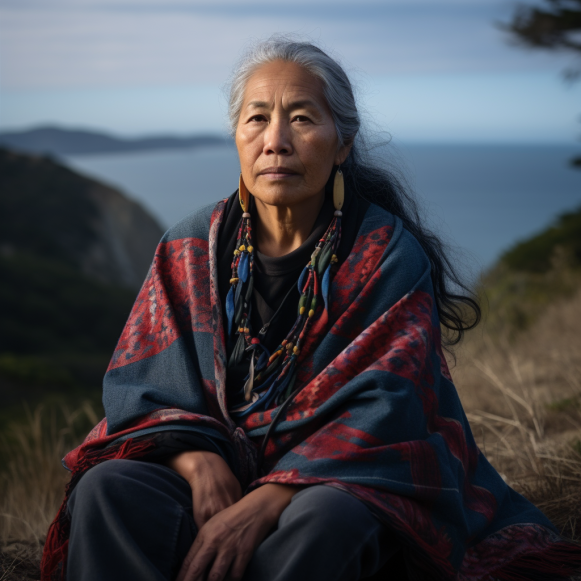Native Americans invited back to help protect and preserve their former lands

In historic policy shift, long-ousted tribes are collaborating, cooperating and co-managing parks
Theresa Harlan had been warned for decades that her family’s beloved cabin in Point Reyes National Seashore would be demolished, along with all other traces of Coastal Miwok heritage in this fog-veiled, wind-sculpted landscape.
But she now has the park’s assurance that it will remain, a small but symbolic gesture in the growing movement to right historical wrongs and give Native Americans a say in the fate of lands and waters that were once theirs.
“There is a shift,” Harlan, 63, said. “We are treated as stakeholders.”
Long after being forcibly removed, tribes are negotiating collaborative or cooperative roles in 80 national parks, including Point Reyes. This month, federal officials will reveal details about the proposed Chumash Heritage National Marine Sanctuary off the Central California coast, the nation’s first tribal-nominated marine sanctuary designation.
Tribes have larger and more formal co-management roles in four other national parks: Canyon de Chelly National Monument in Arizona, Glacier Bay National Park and Preserve in Alaska, Grand Portage National Monument in Minnesota, and Big Cypress National Preserve in Florida.
The Federated Indians of Graton Rancheria are collaborating with park management to help resolve the contentious debate over the future of the tule elk reserve at Point Reyes. Every meeting includes a tribal representative to discuss elk management strategies, such as whether to remove a two-mile-long fence to allow the animals access to more forage and water. Ranchers claim that such a move would jeopardize their livelihood. Following the close of the public comment period on Monday, the tribe will collaborate with the park on next steps.
“The tribe has a lot of wisdom, a lot of experience, and they’re also interested in helping co-steward this land,” said Craig Kenkel, superintendent of the national seashore. “They have been connected with this land far longer than the National Park Service, the ranchers and other people who got here due to colonialism.”
Following Gov. Gavin Newsom’s historic formal apology for genocide and oppression in 2019, state and county parks are also strengthening tribes’ roles in land management.
“Momentum is growing,” said Monte Mills, director of the Native American Law Center at the University of Washington School of Law in Seattle.
“It’s a matter of legal justice, given the history of dispossession and removal that resulted in the exclusion of tribal folks,” he stated. He added that tribal input could help the government take better care of the land.
The grand vision behind the establishment of America’s parks was to preserve pristine wilderness. However, many of the landscapes had been domesticated by tribal peoples for millennia.
Tribal evictions began in 1850, when California passed a law that required tribes to be removed, children to be separated from their families, and survivors to be stripped of their cultures and languages. California Gov. Peter Burnett declared in his 1851 State of the State Address that “a war of extermination will continue to be waged between the two races until the Indian race becomes extinct.”
Deb Haaland, a Pueblo, is now the Secretary of the Interior for the United States. Chuck Sams, a Cayuse and Walla Walla tribal member, is the National Park Service’s first Native American director.
In a historic move, the Departments of the Interior and Agriculture signed an order committing to tribal “co-stewardship” in 2021. Last September, national parks announced a “co-stewardship” policy.
Despite these efforts, it remains unclear how much influence the tribes will have.
“Co-stewardship is more than an agency saying, ‘Hey, tribe, can you give us your side of the story?'” Alternatively, ‘Go do this tree-thinning project.’ “It’s about shared decision-making responsibility,” Mills explained. “The direction is positive, but it remains to be seen how much really gets in place.”
The specifics of many of the parks are not yet public and remain shrouded in secrecy due to “government-to-government” confidentiality agreements with tribes, which are sovereign nations. While taxpayers own and manage the parks, meetings with tribes are not open to the public.
However, broad plans are emerging.
A 2021 written agreement at Point Reyes offers the tribes preferential access to land and facilities, as well as special permits for collecting plants, among other rights. Kenkel stated that the goal was to “work as equals in the planning and co-stewardship of the Seashore.”
According to a new report by One Tam, a coalition of four government agencies and the Golden Gate National Parks Conservancy, tribes could help manage invasive plants, wildfire risk, and species monitoring at Mt. Tamalpais State Park. It claims that tribes are entitled to hunting rights as well as free entrance and parking.
Tribes will be involved at Sonoma State Historical Park so that exhibits and signage reflect a more nuanced and accurate view of Native history, according to Noah Stewart, a historian with the California State Parks’ Bay Area District in Petaluma.
“We’ve got to tell the real story — the right story,” he stated. “It’s very long overdue.”
The Amah Mutsun Tribal Band is reintroducing indigenous plant management techniques at Pinnacles National Park. Coast Miwok will assist with mechanical thinning and prescribed burns in Marin’s Tomales Bay State Park. In the far north of the state, Yuroks are repairing the California Coastal Trail. Tribes will collect water samples for scientific monitoring in the proposed Chumash Heritage National Marine Sanctuary.
Members of the Southern Sierra Miwuk have a 30-year agreement to restore the historic Wahhoga Village beneath the towering granite cliffs of Yosemite National Park. A new ceremonial roundhouse designed by native engineers is being built by an all-native crew. The tribe’s last surviving cabin was relocated to its original location this spring.
“It feels fantastic. “It was the vision of our elders,” said Vernett Calhoun, 77, chair of the Wahhoga Committee.
She admitted that the collaboration faces difficulties. “We must meet their expectations.” Regulation after regulation follows. But we can also stand our ground — and build it traditionally,” Calhoun said. “It isn’t always easy, and we don’t always agree.” We just need to keep going.”
Protection and restoration remain a distant dream for Harlan, whose abandoned 1880s-era cabin is riddled with broken windows, graffiti, and other acts of vandalism. The once-tidy yard has become a jungle, overrun with weeds and warped by tree roots. She wants to turn it into a history museum and an ecological garden.
But she now feels respected and is no longer dismissed so quickly.
Kenkel of the Park Service hiked a mile to the remote site for a three-hour meeting with the family, then listened to ancestral history. He promised not to bulldoze the cabin, arranged for the cleanup of a massive trash pile, and promised follow-up meetings.
“I finally feel that we are understood,” Harlan said. “When I call now, he picks up.”






